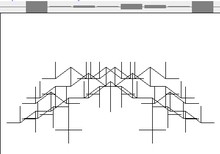The Blind Watchmaker
| File:Blind Watchmaker.jpg Cover illustration by the zoologist Desmond Morris | |
| Author | Richard Dawkins |
|---|---|
| Subject | Evolutionary biology |
| Publisher | Norton & Company, Inc |
Publication date | 1986 |
| ISBN | 0-393-31570-3 |
| OCLC | 35648431 |
| 576.8/2 21 | |
| LC Class | QH366.2 .D37 1996 |
| Preceded by | The Extended Phenotype |
| Followed by | River Out of Eden |
The Blind Watchmaker: Why the Evidence of Evolution Reveals a Universe without Design is a 1986 book by Richard Dawkins in which he presents an explanation of, and argument for, the theory of evolution by means of natural selection. He also presents arguments to refute certain criticisms made on his previous book, The Selfish Gene. (Both books espouse the gene-centric view of evolution.)
Overview
In his choice of the title for this book, Dawkins refers to the watchmaker analogy made famous by William Paley in his book Natural Theology. Paley, arguing more than fifty years before Charles Darwin published On the Origin of Species, held that the complexity of living organisms was evidence of the existence of a divine creator by drawing a parallel with the way in which the existence of a watch compels belief in an intelligent watchmaker. Dawkins, in contrasting the differences between human design and its potential for planning with the workings of natural selection, therefore dubbed evolutionary processes as analogous to a blind watchmaker.
In developing his argument that natural selection can explain the complex adaptations of organisms, Dawkins' first concern is to illustrate the difference between the potential for the development of complexity of pure randomness as opposed to that of randomness coupled with cumulative selection. He demonstrates this by the example of the weasel program. Dawkins then describes his experiences with a more sophisticated computer model of artificial selection implemented in a program also called The Blind Watchmaker, which was sold separately as a teaching aid (open source implementations are currently available[1]). The program uses a concept of "biomorph" - mathematical organism whose shape (in some implementations also colour) is defined by its "genome", a vector of numeric values. "Genes" (values in a vector) drift slowly inside the defines boundaries, each at its own speed. There is no selection involved.

In an appendix to a later edition of the book (1996), Dawkins explains how his experiences with computer models led him to a greater appreciation of the role of embryological constraints on natural selection. In particular, he recognized that certain patterns of embryological development could lead to the success of a related group of species in filling varied ecological niches, though he continued to maintain that this should not be confused with the ideas associated with group selection. He dubbed this insight the evolution of evolvability.
After arguing that evolution is capable of explaining the origin of complexity, near the end of the book Dawkins uses this to argue against the existence of God: "a deity capable of engineering all the organized complexity in the world, either instantaneously or by guiding evolution ... must already have been vastly complex in the first place ..." He calls this "postulating organized complexity without offering an explanation."
In its preface, Dawkins states that he wrote the book "to persuade the reader, not just that the Darwinian world-view happens to be true, but that it is the only known theory that could, in principle, solve the mystery of our existence."
References
- Dawkins, Richard (1996) [1986]. The Blind Watchmaker. New York: W. W. Norton & Company, Inc. ISBN 0-393-31570-3.
- Maynard Smith, John (1986). "Evolution for those that have ears." New Scientist 112 (Nov. 20): 61.
